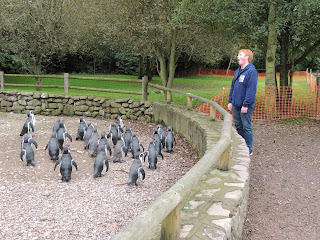Seeing as I do not have class on Wednesday, I decided to take advantage of it and get out to explore even more of the surrounding County Cork. Meng and I took a train to Fota, a very small, one-platform station on the Cork-Cobh route. The first thing I noticed as we got off the train were the fenceposts surrounding the tracks. One side had been painted yellow with black spots, reminiscent of a giraffe, while the other side was white and black stripes, like a zebra. Literally within 100m of the train station was the entrance to Fota, and apparently the only spot of major significance serviced by the train station. A massive, two-panel gate, striking visions of Jurassic Park, rose to meet us. We bought our tickets and entered. Fota is a wildlife park, known for its free-ranging animal exhibits. All of the docile animals are free to roam the entire park, and frequently do, being wholly unintimidated by humans. The less friendly or territorial animals are on small islands within the park, free to roam within their allotted space. The truly dangerous animals are kept behind electric fences (it must be a tribute to Jurassic Park) to keep the visitors safe. The very first mini island contained flamingos, dutifully standing on one leg, and monkeys, of which there were far too many species for me to identify. Within a moment of entering the park, a large peahen crossed paths with us on the road, dwarfing the swans of Cork.
The main lake area contained moderately sized islands completely inhabited by monkeys. There were several species on each island, co-existing, although as we were walking by, there was a great commotion. Some of the monkeys had formed a group and began screeching and howling at an apparent newcomer to the group who was chased around the island. This altercation lasted several minutes, repeating itself throughout the course of the day. The area between the monkey-island-containing lakes was filled with Wallabys, Kangaroos, and very large rabbit-like rodents called Maras. The kangaroos in particular were very calm and would let you get close enough to pet them (although actually petting the animals was prohibited). The park does contain some more traditional habitats with enclosures. One such enclosure contained two gigantic Sea Eagles and a Harbour Seal. Another housed some thirty Humboldt Penguins, waddling and swimming around. They also started vocalizing with you if you gave them a bit of attention. As I was making music with the penguins, a loud whooping call rose from one of the monkey islands. The remarkably loud, otherworldly sound lasted about 15 minutes. I later found out that the noise was emitted by Siamang Gibbons, who use the vocalizations to reinforce pair bonds and establish territory. It turns out the the park has two teenage monkeys living on a separate island from their parents, and the calls help them communicate.
The rest of the park was similar to the San Diego Wild Animal Park in that it had large fields with the more savannah-inhabiting species. Giraffes, bison, zebras, and even two cheetahs roamed behind electrified fences (I expected the velociraptor exhibit to show up any minute).
Outside of the actual animal park are the Fota gardens and House. The Fota Estate has been owned by the Fota family for over 200 years, and sits at the end of a long driveway overlooking an impossibly green pastoral country road, that was eerily shrouded in fog. If you recall from an earlier entry, the Market House in Cobh, some 6 km away, was built with funds from James Smith Barry in 1852, a Fota himself. The Fota House was closed for the season, but the formal gardens and the arboretum were open to the public, and free.
The name Fota comes from the Irish "fód te", meaning "warm soil". Indeed, the Fota family collected many rare species of trees and plants that were cared for and displayed in the arboretum. Today the arboretum contains some interesting features. A stone circle containing a ring of black, high-backed wooden chairs facing inward marks one of the major intersections within the arboretum's walking trail. This particular art piece reminded Meng of something out of Harry Potter, a sort of Death Eater conference table. The arboretum also had a pond covered with lily pads and a fernery, literally, a section of gardens with stone caves and ferns.
Fota Island proved to be a very enjoyable place to visit, and the extensive gardens would merit a return on their own, with the additional bonus of being free, like so much of Ireland's historical attractions.

No comments:
Post a Comment
Go raibh maith agat.
(Irish, literal: A thousand thanks)
Thanks a million!